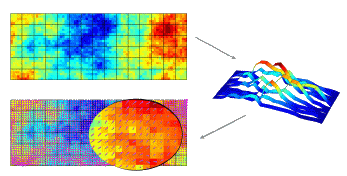GeoScale - Direct Reservoir Simulation on Geocellular Models
|
Multiscale methods
SINTEF is a research institute without teaching activities by itself. Instead, we supervise master and PhD students. This not only allows us to explore new research ideas but is also central in our efforts to make open-source reservoir simulation tools.
Multiscale pressure solvers. Multiscale simulation is a promising approach to facilitate direct simulation of large and complex grid-models for highly heterogeneous petroleum reservoirs. We have for many years worked on developing a particular multiscale methods, the multiscale mixed finite-element (MsMFE) method. We use this method in various forms in several of our ongoing projects, and the method has been implemented for general unstructured grids in MRST. Connected to our ongoing research, there are several interesting and challenging topics for student projects and master theses:
We offer supervision at NTNU and at the universities of Bergen and Oslo. For all the projects listed above, you must work in close collaboration with the GeoScale team and we expect you to do quite a bit of programming. Contact: Knut-Andreas Lie |
||
